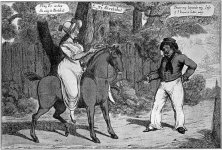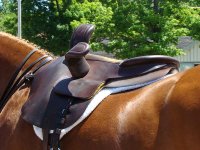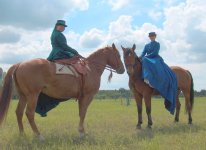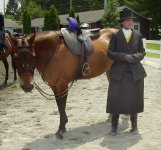♘امیرحسین♞
♘ مدیریت انجمن اسب ایران ♞
Sidesaddle riding is a form of Equestrianism that uses a type of saddle which allows a rider (usually female) to sit aside rather than astride a horse, mule or pony. Sitting aside dates back to antiquity and developed in European countries in the Middle Ages as a way for women in skirts to ride a horse in a "modest" fashion while also wearing fine clothing. It has retained a specialty equestrian niche even in the modern world.
History
The earliest depictions of women riding with their legs on the side of the horse can be seen in Greek vases, sculptures, and Celtic stones. Medieval depictions show women seated aside with the horse being led by a man, or seated on a small padded seat (a pillion) behind a male rider. 9th century depictions show a small footrest, or planchette added to the pillion. In Europe, the sidesaddle developed in part because cultural norms for the upper social classes dictated that it was unbecoming for a woman of apparent wealth or high social status to straddle a horse while riding. The practice was reinforced by folk beliefs suggesting that riding astride could destroy a girl's virginity, impair her ability to bear children, or provide a lady with an unnatural sexual stimulation. Riding sidesaddle was also practical, since long dresses were the required fashion. However, in spite of cultural pressures, not all women of the nobility adopted the sidesaddle at all times. Women such as Diane de Poitiers (mistress to Henry II of France) and Marie Antoinette were known to ride astride. Catherine the Great of Russia went so far as to commission a portrait showing her riding astride wearing a male officer's uniform.
The earliest functional "sidesaddle" was credited to Anne of Bohemia (1366-1394). It was a chair- like affair where the woman sat sideways on the horse with her feet on a small footrest. The design made it difficult for a woman to both stay on and use the reins to control the horse, so the animal was usually led by another rider, usually male, and sitting astride. The insecure design of the early sidesaddle also contributed to the popularity of the Palfrey, a smaller horse with smooth ambling gaits, as a suitable mount for women.
A more practical design, developed in the sixteenth 16th century, has been attributed to Catherine de Medici. In her design, the rider sat facing forward, hooking her right leg around the pommel of the saddle with a horn added to the near side of the saddle to secure the rider's right knee. The footrest was replaced with a "slipper stirrup", a leather-covered Stirrup iron into which the rider's left foot was placed. This saddle allowed the rider to both stay on and to control her own horse, at least at slower speeds.
Two pommel design
In the 1830s, Jules Pellier invented a sidesaddle design with a second, lower pommel to the sidesaddle. In this design, still in use today, one pommel is nearly vertical, mounted approximately 10 degrees left of top dead center and curved gently to the right and up. The rider’s right leg goes around the top, or fixed pommel, which supports the right thigh of the rider when it is lying across the top center of the saddle. The lower right leg rests along the shoulder of the left (near) side of the horse and up against the second pommel (called the leaping head or leaping horn.) lies below the first on the left of the saddle. It is mounted about 20 degrees off the top of the saddle. This pommel is curved gently downward in order to curve over the top of the rider's left thigh, and is attached in a manner so that it could pivot slightly, to adjust to the individual rider. The rider places her left leg beneath this pommel, with the top of the thigh close or lightly touching it, and places her left foot in a single stirrup on that side.
The impact of the second leaping horn was revolutionary; the additional horn gave women both increased security and additional freedom of movement when riding sidesaddle, which allowed them to stay on at a gallop and even to jump fences while fox hunting. With this design, nearly all recreational equestrian pursuits were opened to women, yet they could also conform to societal expectations for modesty. The leaping horn was the last major technological innovation for the sidesaddle and remains the core of basic design even for saddles of modern manufacture made with space-age materials.
Riding habit
The riding habit worn by woman riding sidesaddle originally was similar to clothing worn in everyday life. It wasn’t until the second half of the 16th century that a riding habit specifically designed for sidesaddle riding was introduced, though sidesaddle habit design still tended to follow fashion of the day. In 1875, the first safety skirt was introduced and later evolved into the open-sided apron.
In the early 20th century, as it became socially acceptable for women to ride astride while wearing split skirts, bloomers, and eventually, breeches, the sidesaddle fell out of general use for several decades. However, a few aficionados kept the tradition alive and the sport enjoyed a revival beginning in the 1970s.
History
The earliest depictions of women riding with their legs on the side of the horse can be seen in Greek vases, sculptures, and Celtic stones. Medieval depictions show women seated aside with the horse being led by a man, or seated on a small padded seat (a pillion) behind a male rider. 9th century depictions show a small footrest, or planchette added to the pillion. In Europe, the sidesaddle developed in part because cultural norms for the upper social classes dictated that it was unbecoming for a woman of apparent wealth or high social status to straddle a horse while riding. The practice was reinforced by folk beliefs suggesting that riding astride could destroy a girl's virginity, impair her ability to bear children, or provide a lady with an unnatural sexual stimulation. Riding sidesaddle was also practical, since long dresses were the required fashion. However, in spite of cultural pressures, not all women of the nobility adopted the sidesaddle at all times. Women such as Diane de Poitiers (mistress to Henry II of France) and Marie Antoinette were known to ride astride. Catherine the Great of Russia went so far as to commission a portrait showing her riding astride wearing a male officer's uniform.
The earliest functional "sidesaddle" was credited to Anne of Bohemia (1366-1394). It was a chair- like affair where the woman sat sideways on the horse with her feet on a small footrest. The design made it difficult for a woman to both stay on and use the reins to control the horse, so the animal was usually led by another rider, usually male, and sitting astride. The insecure design of the early sidesaddle also contributed to the popularity of the Palfrey, a smaller horse with smooth ambling gaits, as a suitable mount for women.
A more practical design, developed in the sixteenth 16th century, has been attributed to Catherine de Medici. In her design, the rider sat facing forward, hooking her right leg around the pommel of the saddle with a horn added to the near side of the saddle to secure the rider's right knee. The footrest was replaced with a "slipper stirrup", a leather-covered Stirrup iron into which the rider's left foot was placed. This saddle allowed the rider to both stay on and to control her own horse, at least at slower speeds.
Two pommel design
In the 1830s, Jules Pellier invented a sidesaddle design with a second, lower pommel to the sidesaddle. In this design, still in use today, one pommel is nearly vertical, mounted approximately 10 degrees left of top dead center and curved gently to the right and up. The rider’s right leg goes around the top, or fixed pommel, which supports the right thigh of the rider when it is lying across the top center of the saddle. The lower right leg rests along the shoulder of the left (near) side of the horse and up against the second pommel (called the leaping head or leaping horn.) lies below the first on the left of the saddle. It is mounted about 20 degrees off the top of the saddle. This pommel is curved gently downward in order to curve over the top of the rider's left thigh, and is attached in a manner so that it could pivot slightly, to adjust to the individual rider. The rider places her left leg beneath this pommel, with the top of the thigh close or lightly touching it, and places her left foot in a single stirrup on that side.
The impact of the second leaping horn was revolutionary; the additional horn gave women both increased security and additional freedom of movement when riding sidesaddle, which allowed them to stay on at a gallop and even to jump fences while fox hunting. With this design, nearly all recreational equestrian pursuits were opened to women, yet they could also conform to societal expectations for modesty. The leaping horn was the last major technological innovation for the sidesaddle and remains the core of basic design even for saddles of modern manufacture made with space-age materials.
Riding habit
The riding habit worn by woman riding sidesaddle originally was similar to clothing worn in everyday life. It wasn’t until the second half of the 16th century that a riding habit specifically designed for sidesaddle riding was introduced, though sidesaddle habit design still tended to follow fashion of the day. In 1875, the first safety skirt was introduced and later evolved into the open-sided apron.
In the early 20th century, as it became socially acceptable for women to ride astride while wearing split skirts, bloomers, and eventually, breeches, the sidesaddle fell out of general use for several decades. However, a few aficionados kept the tradition alive and the sport enjoyed a revival beginning in the 1970s.







